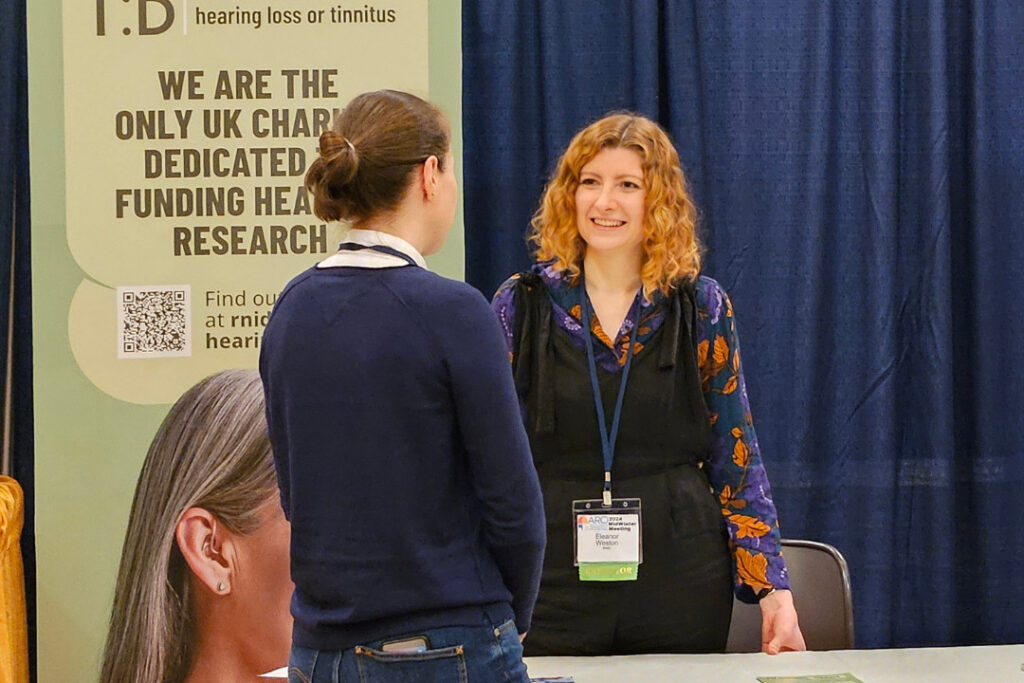Last week Ralph Holme, our Director of Research, and Ellie Weston, our Research Grants Manager, joined researchers from around the world for the annual midwinter meeting of the Association for Research in Otolaryngology – ARO for short – to share and discuss the latest hearing research.
Ralph Holme shares what exciting research breakthroughs they learned of at the conference, and what’s next for RNID funded hearing research.

Gene therapy
Ahead of the conference, news broke that several research teams had successfully restored the hearing of children with a rare form of deafness, caused by a fault in a gene called Otoferlin. So, there was a real buzz – and standing room only – in the auditorium for a series of talks from Decibel Therapeutics, Akouos, Otovia Therapeutics and Fudan University, who were all presenting their results of the first gene therapy for hearing loss.
The results were amazing! Within 30 days of treatment, children went from being profoundly deaf to having only mild to moderate hearing loss. There is no question about it – the research is a game changer. This technology and know-how that has been developed will open the door to a wide range of gene therapies being developed in the future.
RNID research
Research funded by RNID was also presented at the conference, including Jing-Yi Jeng, University of Sheffield, who spoke about her research into the ‘sound sensing’ inner hair cells in the cochlea. She has found that these inner hair cells gradually lose their ability to process acoustic information optimally with age, which is associated with the degree of progression of age-related hearing loss.
Victoria Bajo presented a poster on her lab’s research looking at how sleep interacts with tinnitus. The initial results suggest that changes in brain activity associated with tinnitus are reduced during sleep. This discovery could inform future treatments.

Ellie took part in a funders panel session highlighting the different ways RNID can support research. We have a range of grant schemes supporting research at different stages and helping to kick-start the careers of future research leaders. We hope many of the people we spoke to will consider applying to us for funding in the future.
Our Innovation Seed Fund Award supports new lines of research, like the project presented by Federico Ceriani at the conference showing the potential that machine learning has for the early diagnosis of age-related hearing loss.
There was a huge breadth of research at the conference, ranging from fundamental research into how the inner ear works and how the brain processes signals from the ear, through to research into how noise, age and ototoxic medicines affect the auditory system. Research into how the delicate structures of the inner ear are formed during development was also on show, providing clues as to how we might be able to regenerate damaged cells in the ear to restore hearing.
Making new connections
For the second year running, we setup an exhibition booth. It was a great way to meet new researchers, learn about their research and explain how our Hearing Therapeutics Initiative can help connect researchers to the expertise they need. We now have over 200 members and will be running a series of virtual events during the year to bring the research community together to discuss key challenges.
Finally, it was a chance to thank in person the many scientists who help us by volunteering their time to review grant proposals. Their expert feedback helps us select the projects that will have the most impact.
What’s next?
Over the coming weeks, we will be following up on the many conversations we started and using the insight we gained to shape our work into bringing about treatments for hearing loss and tinnitus.